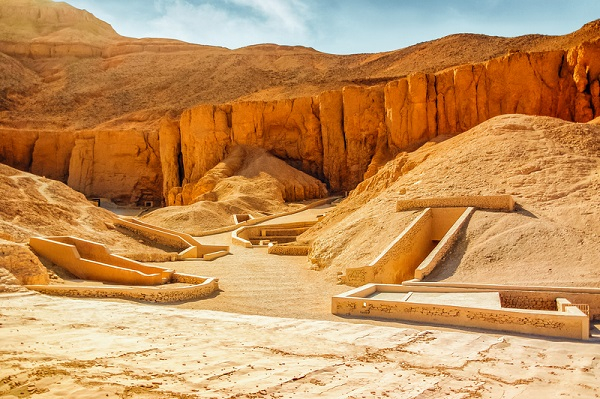

Two traditions that have been widespread in early Egypt had a big consequence on how cremation is regarded in all other cultures. Firstly, the notion of a dead and resurrected rescuer deity who may grant adherents eternity. The other was the theory of a post-mortem assessment. That indicated whatever occurred to the accused in the conclusion would rely on how well he survived. Many reports say that the Egyptian community was split into three categories the living, the divine, and the buried. Throughout their historic range, the historical Egyptians spent a substantial quantity of effort studying death and making arrangements for the hereafter.

Valley of kings. The tombs of the pharaohs. Tutankhamun. Luxor. Egypt. Ancient monument of architecture. Museum. Excavation. Vacation holidays background wallpaper
The beliefs of an afterlife, everlasting life, and spirit regeneration were all fundamental to Egyptian religious doctrines. The Duat was regarded, as the sole gateway to the afterlife. By proceeding through the deceased person's burial, this one was fulfilled. When a soul first approached that dimension, they encountered a corridor enriched with a collection of fascinating sculptures and another depiction of the god Horus with the hawk-like head. Both kings and commoners likely proceeded by alternative means towards the afterlife. Souls were carried inside and presented to the powerful deity Osiris. Osiris would assess the worthiness of the departed spirits and reward individuals judged worthy of a pleasant paradise. The belief in “everlasting life” was prevalent in Ancient Egypt.
Before they could progress to the last levels of the afterlife, the dead had to overcome several obstacles. Egyptian tombs served as both a place to bury the deceased and a conduit for the soul's passage to the underworld. The majority of what was discovered in a tomb was determined by the status of the individual placed there. To aid the deceased in the afterlife, the Egyptians painted their tombs and coffins with various religious inscriptions and spells over the years. The Books of the Netherworld included many works that described the afterlife and functioned as a roadmap for the departed on their last journey. The early Egyptians developed the approach of mummification because they thought that the body was required to be stored so that the deceased may be recreated in the afterlife. It was traditional to put offerings close to the deceased's body because many Egyptians believed the tomb was a residence for the dead.
The afterlife was thought to include several stages, according to ancient Egyptian theory. It was thought that the first stage included the means of conveyance that would ultimately lead their deceased souls to eternity. People had to go through a variety of stages, but the path they chose depended on their rank. One's standing among their superiors was the factor that was most consistently influential in choosing what passage was chosen. Despite the variations among travellers, afterlife ideas were largely influenced by religious philosophies. Pharaohs who had passed away were the only ones permitted to take boats to the underworld. Ra, the sun god of Egypt, was thought to sail towards the underworld as the sunset.
To appropriately address every one of the forty-two Evaluators of Maat by name and to list the offences they did not engage in while they were alive, the deceased's first responsibility was to perform. The dead were able to prove their cleanliness and sinlessness through this method, as well as their knowledge of the names of each judge or Ren. The deceased was employed to measure their spirit against the wing of Maat after being told they were innocent.
The Egyptians had a variety of choices for determining their fate. A lot of ancient Egyptians' ceremonies for such a future were aimed at persuading the god to offer them one more chance at living. Women in Ancient Egypt were compelled to redefine their identity by adopting more male characteristics. Because of his virility, Osiris, the supreme emperor of the underworld, won praise for his tremendous supremacy. Goddesses were far more watchful, and the general concept of the gods tied their male characteristics to resurrection.
The inhabitants of Egypt assumed that even upon demise, the soul forms would remain alive inside a hereafter that was remarkably identical to the earthly one. The departed would have to find their way through a treacherous journey throughout the cemetery and the final verdict before even being given entrance. From the perspective of the Egyptians, the mummified body remains functioned as the residence for this spirit or soul.
The traditional Egyptians had the thought that once they died unexpectedly, their spiritual beings would remain on like the physical ones. But passage to this eternity was not assured. The dead would have to make a journey through the afterlife facing many dangers and then represent themselves before a final decision. Ancient Egyptians trusted in an eternity, which altered their assumptions about mortality. To guarantee that souls would endure even after they left the earth, individuals used to serve their goddesses both during and following their existence there.
Q1. How was the behaviour of Egyptians with the dead body?
Ans. The Egyptian pharaohs were typically mummified and placed in magnificent tombs after their death. Relatively similar treatment frequently applied to the people of nobility, authorities, and, commoners. Unfortunately, the procedure was costly and out of many people’s reach.
Q2. What was the soul known by the Egyptians?
Ans. The ka, ba, and akh constitute the Egyptian Soul. The ka, the akh, and the ba according to the Ancient Egyptians, were the three components of the soul. Everyone held the ka and ba spiritual beings, but only those who were capable of maat kheru were permitted to hold the akh.
Q3. How did the oldest Egyptians get ready to die?
Ans. Menna was required to be mummified because the Ancient Egyptians considered doing so vital for a successful transition into the afterlife. His internal organs were separated and maintained in canopic jars.